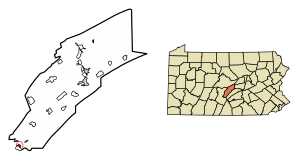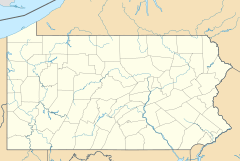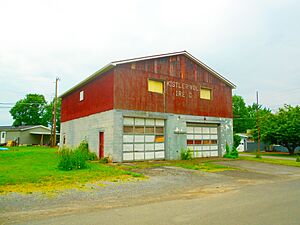Kistler, Pennsylvania facts for kids
Quick facts for kids
Kistler, Pennsylvania
|
|
|---|---|
|
Borough
|
|

Street in Kistler
|
|

Location of Kistler in Mifflin County, Pennsylvania.
|
|
| Country | United States |
| State | Pennsylvania |
| County | Mifflin |
| Incorporated | 1925 |
| Government | |
| • Type | Borough Council |
| Area | |
| • Total | 0.25 sq mi (0.65 km2) |
| • Land | 0.25 sq mi (0.65 km2) |
| • Water | 0.00 sq mi (0.00 km2) |
| Population
(2020)
|
|
| • Total | 291 |
| • Density | 1,150.20/sq mi (444.74/km2) |
| Time zone | UTC-5 (Eastern (EST)) |
| • Summer (DST) | UTC-4 (EDT) |
| Zip code |
17066
|
| Area code(s) | 814 |
| FIPS code | 42-40016 |
| Local phone exchanges: 542, 543 | |
Kistler is a small town located in Mifflin County, Pennsylvania, in the United States. In 2020, about 292 people lived there. It is governed by a Borough Council.
Contents
Geography of Kistler
Kistler is found at these coordinates: 40°22′50″N 77°52′4″W / 40.38056°N 77.86778°W. It covers a total area of about 0.3 square miles (0.65 square kilometers). Most of this area is land, with a very small part being water.
History of Kistler, Pennsylvania
Kistler, Pennsylvania, is known as a "Company Town." A Company Town is a place built and run by a single business. These towns were common between 1880 and 1930, during the early days of big industries.
Kistler was created to provide good homes for workers close to a large factory. The town was built and owned by the Mount Union Refractories Company (MURC). This company had a big brick-making plant near Mount Union, Pennsylvania.
MURC wanted to create a great living environment for its employees. They believed this would help workers be more efficient. To achieve this, the company hired a famous town planner named John Nolen. Nolen designed many towns, including over 25 company towns. In his 1927 book, New Towns for Old, Nolen explained how Kistler was planned.
How Kistler Was Developed
The town was built in 1918. At that time, the Mount Union Refractories Company had about 700 employees. Kistler was placed on the east side of the Juniata River. It was about one and a half miles from the factory.
The company bought about sixty acres of land across the river. This helped keep the town away from the dust and noise of the factory. The town's location was shaped like a triangle, with the Juniata River, the Pennsylvania Railroad, and farmland around it.
Kistler's Town Layout
John Nolen's design for Kistler didn't have one main center point. However, the most important recreational area was 'Kistler Green'. These well-planned open spaces gave all residents places to relax and play.
Park Road and Nolen Street were the two main roads leading into the town from the south. State Street ran next to the railway. Nolen's original plan also included space for a future train station.
Street Design in Kistler
Kistler's design featured two main street widths. The 40-foot wide streets had 18 feet for the road and 22 feet for sidewalks and plants. The 70-foot wide streets had two lanes with a 22-foot parking strip in the middle.
These street widths helped give lot owners more space while saving on paving costs. In the early days, when there wasn't much traffic, the streets also served as safe play areas for children.
Park Features and Green Spaces
Nolen's design kept many natural wooded areas. These areas had trees like willow, locust, sycamore, and oak. The riverbank was set aside for parkland.
The northern part of the park had a playground and picnic spots. The southern part included a boat landing, an athletic field, a baseball diamond, and a field house.
Housing Design in Kistler
The houses built for employees had different styles. They were either detached (standing alone) or semi-detached (connected to one other house). This variety was meant to give residents a sense of individuality. It also aimed to create the best living environment for families.
Each house was built on a lot 40 feet wide and 100 feet deep. In total, almost 200 homes were built. These houses had four to eight rooms, and all included their own bathrooms and porches.
Community Wellbeing in Kistler
It was clear that John Nolen and the Mount Union Refractories Company cared about the people living in Kistler. The town's design aimed to provide comfortable homes and surroundings. It also tried to create a feeling of belonging and community among the residents.
John Nolen wrote about Kistler's success in his book New Towns for Old (1927). He said that Kistler was one of the best places in the country where affordable housing for workers was successfully created for both the employer and the employees.
Population of Kistler
| Historical population | |||
|---|---|---|---|
| Census | Pop. | %± | |
| 1930 | 518 | — | |
| 1940 | 494 | −4.6% | |
| 1950 | 468 | −5.3% | |
| 1960 | 391 | −16.5% | |
| 1970 | 369 | −5.6% | |
| 1980 | 364 | −1.4% | |
| 1990 | 314 | −13.7% | |
| 2000 | 344 | 9.6% | |
| 2010 | 320 | −7.0% | |
| 2020 | 292 | −8.7% | |
| 2021 (est.) | 291 | −9.1% | |
| Sources: | |||
According to the census from 2000, Kistler had 344 people living there. There were 138 households and 90 families. The population density was about 1,341 people per square mile.
Most of the people in Kistler were White (97.38%). A small number were African American (0.58%), Asian (0.29%), or from two or more races (1.74%). About 0.58% of the population was Hispanic or Latino.
In 2000, about 39.9% of households had children under 18. About 42.8% were married couples. The average household had 2.39 people. The average family had 2.95 people.
The population was spread out by age. About 29.9% were under 18. About 31.4% were between 25 and 44 years old. The median age was 34 years. This means half the people were younger than 34 and half were older.
The median income for a household in Kistler was $25,089. For families, it was $27,500. About 28.4% of all people in Kistler lived below the poverty line. This included 31.1% of those under 18 and 30.6% of those 65 or older.
See also
 In Spanish: Kistler para niños
In Spanish: Kistler para niños





